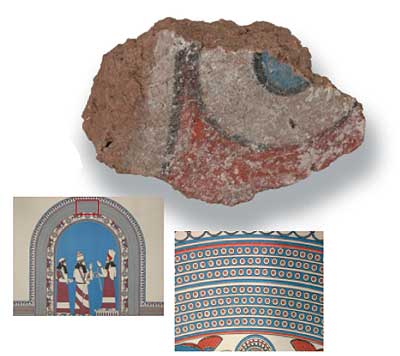 Original
Source
Original
Source
Mesopotamia's true colors
Using a scanning electron microscope
(SEM), conservators at the Oriental Institute (OI) correctly
reidentified the pigments on this mud-brick wall fragment
(at right). From Khorsabad, Iraq, the capital city of Assyrian
King Sargon II (721-705 B.C.), the 6 x 10 cm fragment was
probably part of a geometric painting that graced the palace
walls (see reconstructions below). In storage since the
1930s, the fragile piece needed strengthening treatment
before the OI Mesopotamian Gallery opens in fall 2003.
Before using
modern materials during the treatment, the conservators
needed to analyze the pigments. Although OI publications
from the 1930s said mercuric sulfide was used for the red
color and lapis lazuli (a sulfur containing sodium
aluminum silicate) for the blue, the conservators were skeptical:
those pigments were rarely used by Sargon's time.
For a closer look, OI researcher Vanessa
Muros used the geophysical-sciences department's SEM, which
provides high-resolution, highly magnified images and identifies
the presence and proportion of elements. The scan revealed
iron, not mercury, in the red pigment, indicating an oft-used
iron-oxide-based material. The blue dye contained copper,
silica, and calcium—not sodium—and
was probably "Egyptian Blue," commonly used in
antiquity.
The scan offered reassurance that
a diluted resin wouldn't harm the fragment. It also showed,
then-OI Museum Director Karen Wilson says, that the Assyrians
"were using a more elaborate process of manufacturing
pigments than we previously thought."
— A.B.



![]() Contact
Contact
![]() About
the Magazine
About
the Magazine ![]() Alumni
Gateway
Alumni
Gateway ![]() Alumni
Directory
Alumni
Directory ![]() UChicago
UChicago![]() ©2002 The University
of Chicago® Magazine
©2002 The University
of Chicago® Magazine ![]() 5801 South Ellis Ave., Chicago, IL 60637
5801 South Ellis Ave., Chicago, IL 60637![]() fax: 773/702-0495
fax: 773/702-0495 ![]() uchicago-magazine@uchicago.edu
uchicago-magazine@uchicago.edu
